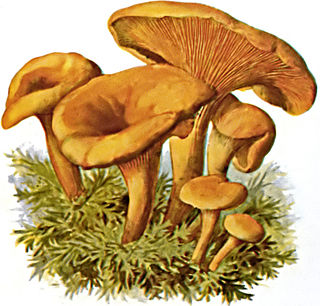
Asuras are a class of beings in Indian religions. They are described as power-seeking clans related to the more benevolent Devas in Hinduism. In its Buddhist context, the word is sometimes translated "titan, "demigod", or "antigod".

Deva means "heavenly, divine, anything of excellence", and is also one of the terms for a deity in Hinduism. Deva is a masculine term; the feminine equivalent is Devi.

An asura in Buddhism is a demigod or titan of the Kāmadhātu. They are described as having three heads with three faces each and either four or six arms.

Indosylvirana aurantiaca, commonly known as the golden frog, is a species of frog endemic to the Western Ghats of India. The species is also known as the Trivandrum frog, the common wood frog, or the small wood frog.

Hygrophoropsis aurantiaca, commonly known as the false chanterelle, is a species of fungus in the family Hygrophoropsidaceae. It is found across several continents, growing in woodland and heathland, and sometimes on woodchips used in gardening and landscaping. Fruit bodies (mushrooms) are yellow–orange, with a funnel-shaped cap up to 8 cm across that has a felt-like surface. The thin, often forked gills on the underside of the cap run partway down the length of the otherwise smooth stipe. Reports on the mushroom's edibility vary – it is considered poisonous, but has historically been eaten internationally.

The Hygrophoropsidaceae are a family of mushrooms that are gilled in appearance but lie within the Boletales. The family contains 18 species within two genera: Leucogyrophana and Hygrophoropsis, with the best-known member being the "false chanterelle", Hygrophoropsis aurantiaca. Hygrophoropsidaceae was circumscribed by French mycologist Robert Kühner in 1980, with Hygrophoropsis as the type genus. Unlike most members of the Boletales, Hygrophoropsidaceae species are saprophytic wood-rotting fungi that cause brown rot in their hosts. The genera Austropaxillus and Tapinella, once placed in this family, are now classified in the Serpulaceae and Tapinellaceae, respectively.
The Gemmatimonadetes are a phylum of bacteria established in 2003. The phylum contains two classes Gemmatimonadetes and Longimicrobia.
Pseudomonas aurantiaca is an orange Gram-negative soil bacterium, originally isolated from the rhizosphere soil of potatoes. It produces di-2,4-diacetylfluoroglucylmethan, which is antibiotically active against Gram-positive organisms. It has shown potential for use as a biocontrol agent against plant-pathogenic microbes. Based on 16S rRNA analysis, P. aurantiaca has been placed in the P. chlororaphis group.

Gynura is a genus of flowering plants in the daisy family Asteraceae endemic to Asia. The best known species is Gynura aurantiaca, often grown as a house plant. This plant is commonly known as "purple passion" because of the velvety purple leaves.

Asura is a genus of moths in the subfamily Arctiinae erected by Francis Walker in 1854.

Agoseris aurantiaca is a species of plant in the sunflower family, commonly called orange agoseris or mountain dandelion. It is widespread and common in western North America from Alaska and the Northwest Territories in Canada southward to California, Arizona, and New Mexico, and eastward as far as the Rocky Mountains and the Black Hills. There are also isolated populations in the Chic-Choc Mountains on the Gaspe Peninsula and in the Otish Mountains of central Quebec.

Guarianthe aurantiaca is a species of orchid. It is widespread across much of Mexico, south to Costa Rica. The diploid chromosome number of G. aurantiaca has been determined as 2n = 40.
Aurantilaria aurantiaca is a species of sea snail, a marine gastropod mollusk in the family Fasciolariidae, the spindle snails, the tulip snails and their allies.

Asura's Wrath is an action video game developed by CyberConnect2 and published by Capcom. Asura's Wrath was first announced at the Tokyo Game Show in 2010, and was released worldwide in February 2012. The game is playable on PlayStation 3, Xbox 360, Xbox One & Xbox Series X/S via 360 backwards compatibility, and the PlayStation 4 and PC via PlayStation Now.
Stigmatella aurantiaca is a member of myxobacteria, a group of gram-negative bacteria with a complex developmental life cycle.
Asura quadrilineata is a moth of the family Erebidae. It is found on Aru and in Australia.

Cyme sexualis is a moth of the subfamily Arctiinae first described by Felder in 1864. It is found on Ambon, Sulawesi, the Dampier Archipelago. and in New Guinea.
Chrysorabdia aurantiaca is a moth of the subfamily Arctiinae. It is found in India (Assam).
Loxophlebia aurantiaca is a moth of the subfamily Arctiinae. It was described by E. Dukinfield Jones in 1908. It is found in south-eastern Brazil.

Gynura aurantiaca, called purple passion or velvet plant, is a species of flowering plant in the daisy family Asteraceae. It is native to Southeast Asia but grown in many other places as a house plant. In warm regions, it is frequently grown outdoors on patios and in gardens rather than inside buildings, and hence it has escaped into the wild in Africa, Australia, South America, Mesoamerica, Florida, and a few other places.











